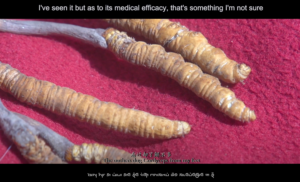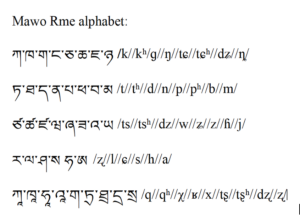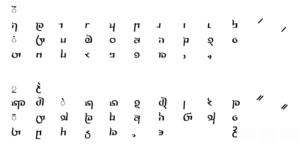
The script referred to as Rma, Rme or Qiang, was apparently (you’ll see) created about 10 years ago for a community—a divided community, perhaps even two communities—on what used to be the borders of China and Tibet, in Ngawa Tibetan and Qiang Autonomous Prefecture.
Two years of hunting for information about it online turned up two sets of apparently conflicting evidence.
The first was an article on Academia about the script’s creation. It seems to be a Duke University master’s thesis, “The Creation of the Qiang Ethnicity, its Relation to the Rme People and the Preservation of Rme Language” (undated, but probably 2014), written by a young man who seems to have two versions of his name, presumably a Tibetan and a Chinese version, as he is identified as Maotao (Tsering) Wen (Bun).
He grew up, he writes, understanding that he was a member of an official ethnic minority called “Qiang.” Over the past three years, though, he came to understand that the Qiang ethnicity, as constructed and promoted by the government, is in essence artificial, consisting not only of the Rme-speaking people who were the core of the minority designated as Qiang, but also many Han Chinese reclassified as Qiang since the 1980s—part of the Chinese government’s ongoing efforts to sculpt and mold the country’s ethnic minorities into acceptable sub-groups that don’t threaten the uniformity of the country as a whole.
“The newly constructed Qiang ‘exhibition’ culture, invented in part for tourism, threatens to displace the culture of this core group of Rme-speaking people.”
One major part of this act of social and cultural engineering was the creation, in the 1980s, of a Qiang script, based on the Qugu variety of a Northern Qiang dialect, using the Latin alphabet. (The Chinese have created a number of scripts for minority languages, showing a curious penchant for extensions of the Latin alphabet.)
“In general,” he writes, “promotion of this system was not very successful.” The letters did not jive well with the complex sound system in Rme language, and were themselves difficult to learn “since most of Rme speakers are illiterate peasants.”
In addition, the Latin-based system had the effect of alienating “a very important group of Rme language speakers, the Tibetan Rme in Heishui County. As a result, the target people for this script shrank over 50%.”
His solution: to create a new script for the Qiang that celebrates both their Rme/Rma heritage and their Tibetan roots.
“Since language is a key basis for any Rme-speaking identity, language preservation offers one of the few ways to resist this process.
“[I]n order to preserve and record Rme language in Heishui, creating a writing system is necessary and urgent. It will not only provide a new writing system for Rme (under the name of Rme and not Qiang) but it will have a positive impact in preserving diversity within the Tibetan culture. Another important potential benefit is that it could be used as an educational tool in elementary schools to address the language barriers that young Rme students have.”
His sensible but radical step was to base the new script on the Tibetan orthography, adding nine additional letters to the traditional Tibetan alphabet.
“[A]s a historically Tibetan Buddhist influenced area, Tibetan letters have been used in this area for hundreds of years. Rme people in Heishui County share cultural and ethnic identities with other Tibetan ethic groups on the Tibetan Plateau. In additional to this, the Tibetan alphabet has already been successfully been developed for different platforms including smart phones. This would be an advantage in the future script promotion. Therefore, I have been working to develop a script based on the Tibetan letters/script.”
The core of the resulting script looks like this:

But this was just the beginning of the mystery, because it left some pretty big questions unanswered (Was his invention used? Was it taught? Was it even allowed?) and to make matters murkier, when I contacted his thesis advisor he told me Tsering had actually done his thesis on a different topic.
Meanwhile, I was discovering a different and apparently contradictory vein of information about an apparently different Rma script consisting of five well-produced videos (two of which are different versions of the same item) uploaded between 2016 and 2022 by Jiuqiao Wei, introducing the script he calls Rma:
A 2016 video about Rma Chongcao Diggers, with text in Chinese and Rma
A video introducing and promoting the Rma script, uploaded in 2017 and reuploaded in 2022
Alphabet of Rma/Qiang script, 2020
The story of Rapunzel in the Qiang language using the Rma script, 2020.
After another slightly anxious beating of the virtual bushes for any evidence that either or both of these hardworking and creative script authors was alive and well, I was lucky enough to reach Jiuqiao Wei, who reported:
“Currently the script (that is, the one in his videos) is very slowly and gradually being adopted by locals. There are mainly 4 counties with varying proportions of native speakers, so the degree of the script’s usage is also quite different.
“One problem with our unofficial promotion of the script is that without any formal system of education in and of the language, most speakers find it very difficult to spell out the words correctly even knowing the individual letters. It is like asking an illiterate to start to write after only learning the alphabet. Unlike English the spelling in Qiang is phonemic so it’s not totally impossible but still as Qiang has too big an inventory of sounds and ambiguity in vowels, it’s very hard.
“As for the backstory, it’s been several years and I’m forgetting some of the details. But basically many agreed there should be a dedicated script to write the language if we want to help preserve it. In order to have the most speakers’ interests, a new script seemed the optimal choice. It’s not easy task though, and honestly I still find several of the glyphs could use some shape modifications [but] for now it’s what it is.”
He also helped clear up a mystery:
Apparently Tsering had decided not to do his Duke master’s thesis on his script, but after he graduated from Duke he decided to take his original topic, with the script, and publish it through Academia so as to make some clearer points about the importance of preserving the language and the culture. The two of them, he wrote, are in contact with each other, doing well and still periodically working on projects of preserving the language.
And progress is indeed being made. Jiuqiao Wei is working with Craig Cornelius of Google to develop a digitized version of the Rma script (for both the southern and northern Qiang languages) and a digital keyboard, which as of November 7, 2023, looked like this:

We wish them all the best.
31.8994° N, 102.2248° E
448/447